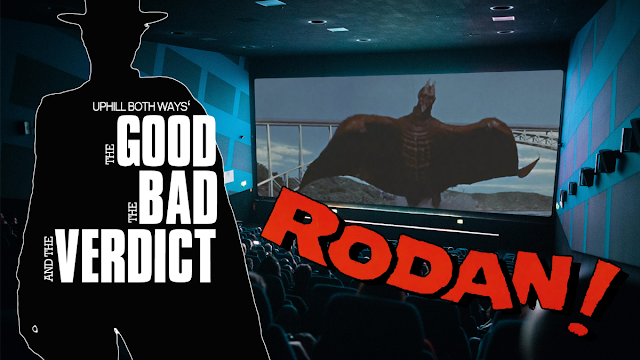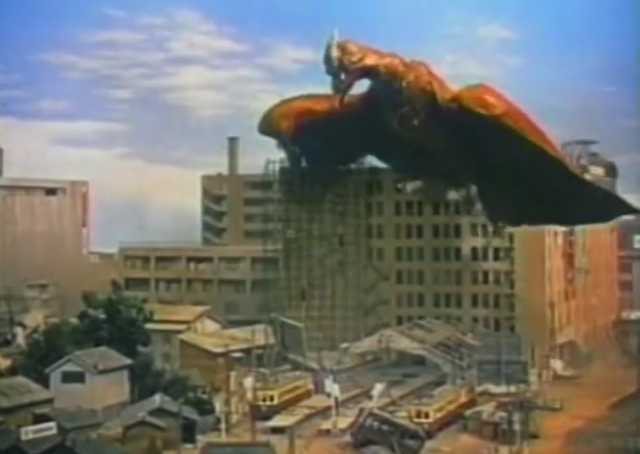In our “The Good, the Bad, and the Verdict” film reviews, Joseph and Mike give their thoughts on a slice of cinema. For this installment, it’s Rodan which is part of our 3rd annual “Kaijuly” look at some giant monster films (of which we both love thanks to seeing them in our childhood of the 60s and 70s).
Synopsis
A mining engineer investigates the deaths of his colleagues, discovering prehistoric nymphs and a creature capable of flying — and wreaking havoc — at supersonic speeds.
Joseph: Mike and I are reviewing the American version of Rodan. Although I prefer the original Japanese version, this one is the one that he and I grew up on, watching it on TV. I like how the larvae are introduced first. Even though we know what the titular monsters look like, it’s cool seeing a secondary monster before the first Rodan reveal — and what a reveal! The insect creatures looked big already, but the freshly hatched Rodan makes them look tiny when it gobbles one up! And we get two Rodans for the price of one! The destruction effects are brilliant, and I would put them right up there with pretty much any Toho kaiju movie of the 1950s and 1960s. The Rodan design is a classic, naturally. You can also have fun trying to determine how many different characters the legendary Paul Frees does dubbing for!
Mike: Rodan works especially well for a number of reasons. The story starts out as a mystery, with a series of strange mining accidents that happen along the way. This develops real tension before the monster is revealed. The movie does a great job of mixing catastrophe movie and creature feature themes, which makes the fear grow. Rodan is a remarkable creation for its day, a huge pterosaur brought to life with realistic suitmation and miniature work. The destructive scenes, especially the aerial attacks on cities, are exciting and show Honda's talent for showing large-scale destruction, which is a common theme in his work. The movie's short length also helps keep the pacing tight, which means there isn't much filler and the audience stays interested the whole time. The human element, which focuses on the miners and their families, gives the story a realistic anchor in the middle of all the crazy things that happen.
Joseph: We don’t get a lot of time to spend with the human characters regarding backstory (and even less so in the American version, though it has been a while since I have seen the Japanese version, and I am trying to avoid comparing and contrasting the two versions here), and the editing of the American version leaves a bit to be desired.
Mike: While Rodan is great in a lot of ways, it does have a few minor problems. The pacing is mostly solid, however the beginning exposition can feel a little slow because it takes a while to get to the monster action. Some of the special effects, such as the wirework employed to show Rodan flying, can look old and less believable than the destruction on the ground. The human characters are mostly generic and don't have a lot of depth, which makes it hard to really care about their personal problems outside the imminent peril. The ending of the movie also feels a little sudden.
Joseph: With truly one of the saddest monster death scenes in Toho’s kaiju filmography, Rodan is a tokusatsu classic that offers more than just army vs. monster action. It feels a bit heavier to me than many of the kaiju origin films, maybe even second only to the original 1954 Gojira (again, the original Japanese version of Rodan even more so). As a youngster, this version of Rodan was one that impressed me with its sympathetic ending and its realistic depiction of carnage, and as an adult, I think those two factors hold up extremely well.
Mike: Rodan was never one of my favorite monsters growing up, but now I can see it as the important movie from the golden age of Japanese monster movies that it is. Even though some of the effects are old and the story for the human characters is limited, the good things about it much outweigh the bad. Honda's direction makes you feel both amazement and fear, showing how powerful a really scary kaiju can be. The movie's concentration on a flying creature sets it apart from other movies that take place on the ground, which makes for some really memorable and powerful scenes. Rodan is a classic for a reason: it has exciting monster action, good tension, and a surprisingly moving ending.
Rodan, from Toho, is available to stream from various services and online outlets. It’s also available on physical media.
Rodan
Directed By: Ishirô Honda
Written By: David Duncan, Takeshi Kimura, Ken Kuronuma
Starring: Kenji Sahara, Yumi Shirakawa, Akihiko Hirata
Run Time: 1h 14m
Rating: NR
Release Date: December 26, 1956





Comments
Post a Comment
Share your thoughts with us